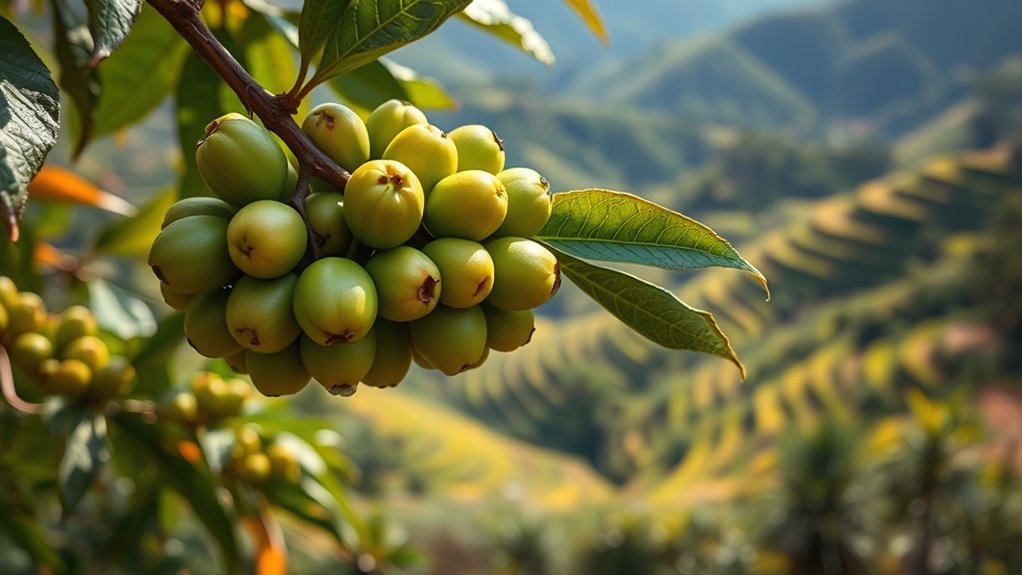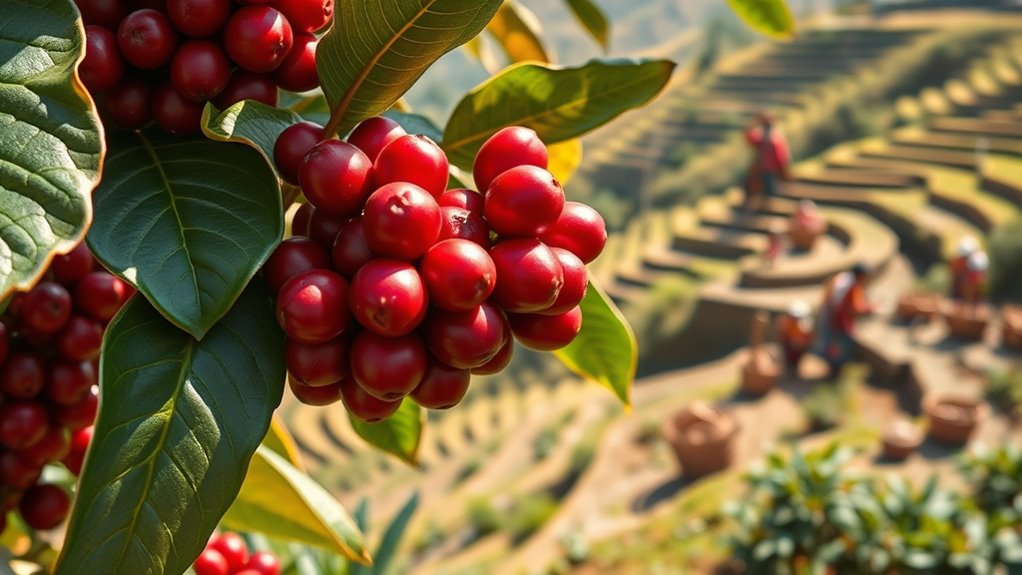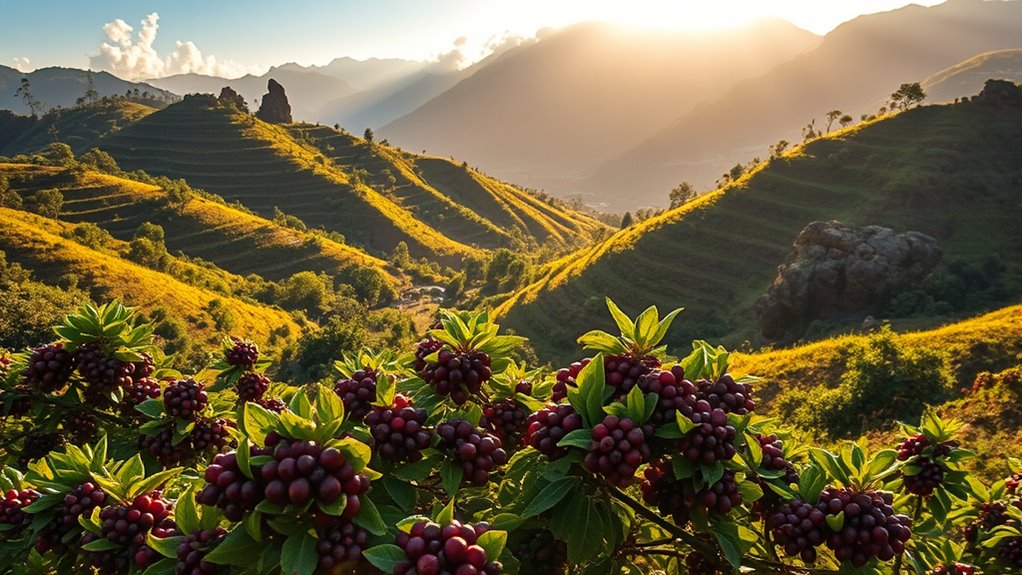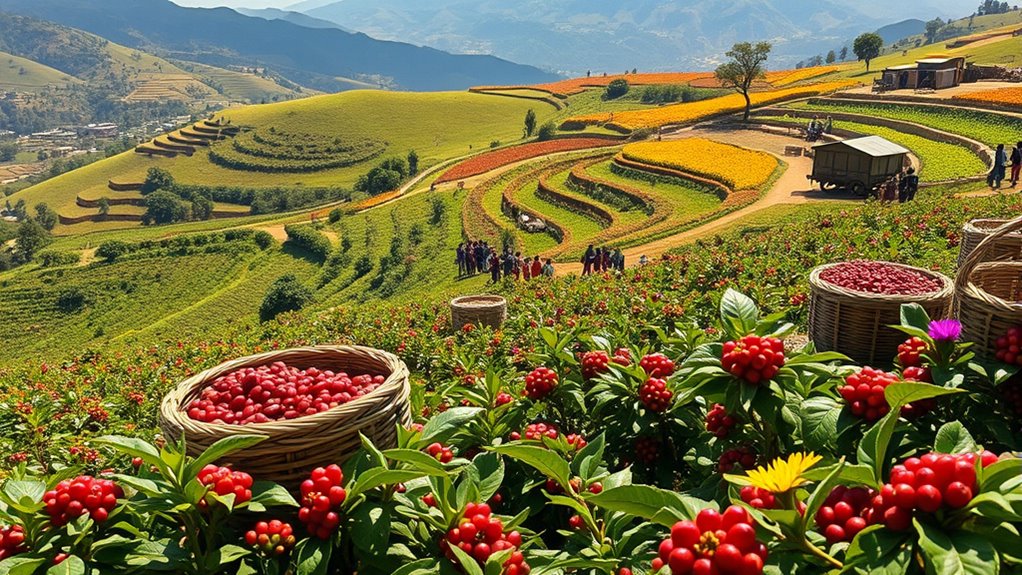Ethiopia is widely recognized as the birthplace of coffee, with a rich history rooted in its culture and traditions. It all began in the 9th century when goat herders noticed their goats dancing after eating red berries. Today, Ethiopia’s coffee is prized worldwide for its unique flavors, regional diversity, and traditional processing methods. Exploring these origins reveals how deeply coffee is woven into Ethiopian society — and there’s much more to uncover behind every cup.
Key Takeaways
- Ethiopia is recognized as the birthplace of coffee, discovered in the 9th century by goat herder Kaldi.
- The country has a rich coffee culture, including traditional ceremonies that symbolize respect and community.
- Ethiopian coffee features unique regional varieties such as Yirgacheffe, Sidamo, and Harrar, known for distinct flavors.
- Coffee cultivation shifted from wild harvesting to organized farming in the 1500s, boosting exports and local livelihoods.
- Ethiopia’s coffee industry is vital to its economy, contributing over a third of foreign exchange revenue and supporting millions of smallholder farmers.
The Legend and Early Discoveries of Ethiopian Coffee

Ethiopian legend tells us that coffee was discovered in the 9th century by a goat herder named Kaldi, who noticed his goats dancing after eating red berries from an unknown shrub in Kaffa. This story, a cherished legend, marks the discovery of coffee’s energizing effects. Kaldi’s keen eye led him to realize that these red berries had special properties, sparking curiosity about their potential. Early on, monks in Ethiopia brewed the first coffee beverage by soaking cherries in hot water, helping them stay alert during long prayer nights. The legend highlights coffee’s deep roots in Ethiopian culture and spiritual life. Today, the story of Kaldi and the Kaffa region remains a symbol of coffee’s mystical origins and its significance in Ethiopian history.
The Development of Coffee Cultivation and Trade in Ethiopia

Since the 1500s, Ethiopia shifted from wild harvesting to organized coffee farming, laying the foundation for its reputation as a major exporter. You see, this shift allowed for systematic coffee cultivation, enabling farmers to develop diverse coffee varieties like those from Sidamo, Yirgacheffe, and Harrar. As coffee cultivation advanced, Ethiopia’s coffee trade expanded through established routes with Yemen and neighboring countries, spreading Ethiopian coffee worldwide. The 19th century marked a significant growth in Ethiopia’s coffee industry, driven by increased production and export. More recently, the Ethiopian Coffee Exchange (ECX), founded in 2008, standardized grading, traceability, and fair trade practices, boosting coffee export and strengthening Ethiopia’s position in the global coffee trade. Today, Ethiopia’s unique coffee varieties remain highly sought after worldwide. Additionally, innovations in sustainable farming practices continue to support Ethiopia’s coffee industry, ensuring environmental preservation and quality production for future generations.
The Cultural Significance of Coffee in Ethiopian Society

Coffee holds a special place in Ethiopian society, serving as more than just a daily beverage—it’s an essential social and cultural tradition. Ethiopian coffee embodies the cultural significance that extends beyond taste, acting as a symbol of hospitality and community. The coffee ceremony is a cherished social tradition, involving roasting, grinding, and brewing coffee in a ritual that can last hours. During the ceremony, hosts offer coffee to guests as a sign of respect and friendship, strengthening social bonds. The three rounds of coffee—abol, tona, and baraka—each carry symbolic meaning, emphasizing spiritual connection and community unity. In Ethiopian society, coffee is a cultural artifact that reinforces identity, spiritual ties, and communal harmony. Additionally, the coffee ceremony reflects the deep-rooted cultural practices that celebrate Ethiopian heritage and social cohesion.
Major Coffee Growing Regions and Their Unique Flavors

The diverse climate, altitude, and processing methods across Ethiopia’s regions give rise to a remarkable variety of coffee flavors. In Yirgacheffe, expect fragrant, aromatic, and floral coffees with bright citrus and fruity notes, often processed via washed or natural methods. Sidamo offers full-bodied, sweet, and complex beans with vibrant acidity, featuring hints of lemon and berry. Harrar is known for its heavy-bodied, spicy, and wine-like coffees with a jammy blackberry taste, usually dry-processed. Guji, part of Oromia, produces organic, mineral-rich coffees with bright, fruity, and floral flavor profiles through traditional processing. Each coffee region’s unique environment shapes these distinct flavors, making Ethiopian coffee a diverse and region-specific treasure for coffee lovers.
Traditional Coffee Processing Techniques in Ethiopia

Ethiopian coffee processing techniques are deeply rooted in tradition, with methods passed down through generations that preserve the country’s unique flavor profiles. One key approach is natural processing, where you dry sun-dried cherries on raised beds for up to four weeks. During this process, you regularly turn the cherries to prevent fermentation and mold, ensuring ideal flavor development. Traditional techniques emphasize sun-drying with the fruit intact, which intensifies fruity and dense flavors. In some cases, fermentation is carefully managed to enhance brightness and clarity, especially in washed processes. These time-honored methods preserve Ethiopia’s reputation for intensely aromatic and wild coffee, allowing the beans to develop their characteristic complexity. Your skill in applying these techniques directly influences the vibrant, distinctive profiles that define Ethiopian coffee. Proper processing techniques are essential to achieve the desired flavor profile and maintain the high quality associated with Ethiopian coffee.
The Role of Coffee in Ethiopia’s Economy and Global Market

You should recognize that coffee is Ethiopia’s top export, making up over a third of the country’s revenue, which shows its critical economic role. About a quarter of the population depends on coffee for their livelihoods, and Ethiopia produces millions of bags annually, with most heading to global markets. The country’s high-quality beans and organized trading systems, like the ECX, position Ethiopia as a key player in the international coffee scene. Additionally, Ethiopia’s reputation is bolstered by its high-quality beans, which are highly sought after worldwide.
Economic Importance of Coffee
Coffee drives Ethiopia’s economy by generating over one-third of its export revenue, making it the country’s top export commodity. Ethiopian coffee, mainly Arabica, supports millions of smallholder farmers who depend on it for their livelihoods. Around 8.2 million bags of coffee are produced annually, with about 60% exported, boosting foreign exchange and strengthening the economy. The Ethiopian Commodity Exchange (ECX), established in 2008, improves transparency, grading, and traceability in coffee trading, ensuring better prices for farmers and traders. Coffee’s essential role in Ethiopia’s economy highlights its significance beyond agriculture, as it fuels national growth and international trade. This global demand for Ethiopian coffee underscores its importance as a key driver of economic development. Diversification of investment assets also helps safeguard the economy against market fluctuations impacting coffee prices.
Export and Market Trends
As one of the world’s top coffee producers, Ethiopia plays an essential role in the global coffee market, mainly exporting around 60% of its annual output of approximately 8.2 million bags. Export trends show a growing demand for Ethiopian coffee, especially specialty coffee, which commands higher prices in the international market. The Ethiopian Commodity Exchange (ECX) streamlines the trading process, improving traceability and ensuring fair trade practices. This system boosts Ethiopia’s competitiveness and transparency in global markets. Additionally, the ECX’s implementation of traceability systems enhances buyer confidence and promotes sustainable practices. While coffee production remains crucial to Ethiopia’s economy, exports generate over one-third of the country’s foreign exchange revenue. With major markets in Europe, Asia, and North America, Ethiopian coffee continues to strengthen its reputation worldwide, reflecting the nation’s rich coffee heritage and expanding global influence.
Smallholder and Industry Impact
Smallholder farmers form the backbone of Ethiopia’s coffee industry, with approximately 4 million relying on coffee cultivation as their main income source. Their efforts sustain both local livelihoods and the global market. Coffee exports contribute over one-third of Ethiopia’s foreign exchange revenue, highlighting its economic importance. The Ethiopian Coffee Exchange (ECX) has improved market access by standardizing grading and traceability, boosting farmers’ earnings. Here’s a snapshot of the industry’s impact:
| Aspect | Details | Impact |
|---|---|---|
| Smallholder farmers | 4 million depend on coffee for income | Livelihood stability |
| Export revenue | Over one-third of foreign exchange earnings | National economy benefit |
| Domestic market | 40% consumed locally | Supports local economies |
| Value chain | Employment across farming and processing | Community development |
Your involvement in this value chain sustains Ethiopia’s economy and global coffee culture.
Ethiopian Coffee Varieties and Their Distinct Characteristics

Ethiopian coffee offers a rich diversity of regional flavors and processing methods that make each variety unique. You’ll notice how the Yirgacheffe beans bring floral and fruity notes, while Sidamo offers a full-bodied sweetness. Harrar and Gesha beans showcase distinct processing techniques that enhance their bold, aromatic profiles. Additionally, the traditional processing methods used in Ethiopia play a vital role in developing the coffee’s distinctive characteristics.
Unique Regional Flavors
Have you ever noticed how Ethiopian coffee varieties showcase remarkably distinct flavors depending on their region? Yirgacheffe is famous for its fragrant, floral aroma with bright citrus and fruity notes, often processed naturally or washed to highlight its delicate flavor. Sidamo offers a full-bodied, sweet profile with vibrant acidity and a lingering aftertaste, thanks to its high-altitude cultivation between 1,550 and 2,200 meters. Harrar stands out with its heavy body, spicy and floral qualities, and a bright, jammy blackberry-like flavor, typically produced through dry (natural) processing methods. Each region’s unique climate, altitude, and processing techniques create these regional flavors, making Ethiopian coffee a diverse and rich tapestry of tastes. This diversity is a true reflection of Ethiopia’s unique coffee heritage. Additionally, coffee cultivation methods play a crucial role in shaping these distinctive regional profiles.
Distinct Processing Methods
The unique flavors of Ethiopian coffee are largely shaped by the processing methods used after harvest. The dry process, or natural processing, involves sun-drying whole cherries, which intensifies fruity and fermented notes, creating dense and complex flavor profiles. In contrast, the washed process removes the fruit before drying, resulting in a cleaner, brighter, and more controlled taste. Many regions, like Yirgacheffe and Sidamo, favor traditional natural processing to highlight fruit-forward and floral characteristics. Emerging processing methods, such as honey or anaerobic techniques, are also gaining popularity, adding innovative flavor nuances. Your choice of processing method directly influences the coffee’s final flavor profile, making Ethiopian coffee a diverse and dynamic experience rooted in its unique production techniques. Additionally, understanding the processing methods can help consumers appreciate the distinct qualities and origins of each coffee batch.
The Impact of Climate and Environment on Coffee Quality

Climate and environment play a crucial role in shaping the quality of Ethiopian coffee. The high-altitude regions like Yirgacheffe and Sidamo offer cool temperatures and steady rainfall, which boost bean density and enhance flavor complexity. Volcanic soils provide essential nutrients and excellent drainage, resulting in vibrant, intricate flavor profiles—ranging from fruity and floral to spicy and wine-like. The natural variation across Ethiopia’s diverse regions creates unique taste characteristics. Precise harvest conditions, thanks to predictable rainfall, allow cherries to ripen fully, ensuring high-quality beans. Additionally, the profound influence of fatherhood and shared cultural values in Ethiopia fosters a strong community dedicated to preserving traditional coffee cultivation practices. However, climate change poses a threat by causing rising temperatures and irregular rainfall, which could disrupt traditional growing conditions. This, in turn, may impact the density, flavor, and overall excellence of Ethiopian coffee.
Modern Trends and Future of Ethiopian Coffee Production

Modern trends are transforming Ethiopian coffee production as producers embrace sustainable practices and high-quality standards. Over half of farmers now use organic or shade-grown methods to protect biodiversity, guaranteeing long-term resilience. The rise of specialty coffee has shifted focus to high-quality beans from regions like Yirgacheffe and Sidamo, commanding premium prices. Innovative processing techniques, such as anaerobic fermentation, help create unique flavor profiles that appeal globally. Digital platforms and e-commerce expand access for Ethiopian farmers and cooperatives, increasing exports and income. Climate change adaptation strategies, including developing resilient coffee varieties and shade management, are central to future planning. These trends ensure Ethiopia’s coffee industry remains competitive, sustainable, and aligned with global consumer demands for traceability and quality.
Frequently Asked Questions
Is Ethiopia the Birthplace of Coffee?
Yes, Ethiopia is the birthplace of coffee. You can explore its rich history, where wild Arabica plants grow naturally in forests like the Kafa Biosphere Reserve. Legend tells of a goat herder named Kaldi discovering coffee’s effects. Ethiopia boasts thousands of indigenous varieties, making it a essential source of global coffee diversity. Its centuries-old tradition highlights Ethiopia’s deep roots as the origin of coffee as you know it today.
Where Is the Birthplace of Coffee in the World?
You might wonder where coffee originated. The answer is Ethiopia, specifically the Kafa region in southwestern Ethiopia. Here, wild Arabica coffee plants first grew, and it’s recognized worldwide as the birthplace of coffee. Ethiopian goat herders in the 9th century discovered its energizing effects, leading to its global popularity. With over 6,500 native varieties, Ethiopia’s climate and biodiversity created the perfect environment for coffee’s birth.
What Is so Special About Ethiopian Coffee?
You’ll find Ethiopian coffee special because of its incredible diversity—over 1,000 varieties with unique flavors. The high-altitude regions like Yirgacheffe and Harrar produce distinct floral, fruity, and spicy notes. Traditional processing methods boost its vibrant, complex taste. Plus, its wild origins give it an intense aroma and unique character. It’s not just coffee; it’s a cultural experience rooted in history and rich tradition.
Who Invented Coffee, Yemen or Ethiopia?
You might wonder who truly brought coffee into the world—Yemen or Ethiopia. The truth is, Ethiopia holds the title as the birthplace, with wild plants thriving long before anyone cultivated them. Yemen, however, played an essential role in popularizing and brewing coffee as a beverage in the 15th century. So, while Yemen helped spread it, Ethiopia’s forests hold the roots of coffee itself.
Conclusion
As you explore Ethiopian coffee, you realize its story is far from over. From ancient legends to modern innovations, the country’s rich traditions and unique flavors continue to evolve. But what’s next for Ethiopia’s coffee heritage? Will new challenges threaten its legacy or inspire groundbreaking changes? One thing’s certain: the future of Ethiopian coffee holds secrets waiting to be uncovered, and you won’t want to miss what’s coming next.






